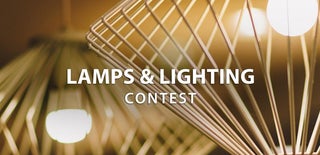Introduction: Anti-Gravity LED Lantern
Is that floating? Suspended with a rubber band and wires...? A string of fairy lights and a rubber band to be exact.
This is held together by a balance of forces pulling in different directions. Those wires on the sides are actually pulling up!
Also known as Tensegrity, or tensile integrity, describes a system of isolated, compressed components within a network of chords that are under continuous tension. A structure that experiences this form of floating compression gains strength from the chords under tension which suspend the compressed components.
Once you get the set up, you can find scraps in the garage and throw one together like this.
Supplies
Materials:
- 2 platforms, in this project scrap 2x4 approximately 7in long. Can be any two equally sized pieces of wood.
- 8 screw-in eyelets, found these at dollar tree in the Hardware Picture Hanging Kit
- 2 garage screw-in hooks, found at any hardware store. The hook must overhang the screw to work.
- 1 Fairy LED lights set
- various rubber bands or string
- 3 feet string
- 2 paperclips
- 1 sheet of printer paper
Suggested Tools:
- Drill
- 1/4" and 1/16" drill bit
- Ruler
- tape
Step 1: Pilot Holes
Garage hooks will not screw into wood without pilot holes. They are intended for drywall.
Using a 1/4" dill bit and ruler to measure and mark the depth of your platform. Take a ruler to measure the thickness of your wood and mark that length on your bit with tape so you don't drill through.
Use a 1/16" bit for the eyelets. Drill about 1/4" from the corner and a 1/4" into the wood.
Step 2: Hooks and Eyelets
Hand screw in the Garage Hooks and eyelets into your platforms. You should have two of the same platforms.
The Garage hooks overhang must be over center. Bend the hooks over like shown or use better hooks than I did.
Step 3: Platform Support
Using the sheet of paper and paperclips, lay over your platforms and mark the paper to the edge. This will be your fold mark.
Fold the paper so it rolls to the intended height of the platforms. Use paperclips to hold the roll.
This roll will hold the platforms at proper spacingso you can feed the side wires through the eyelets.
Step 4: Wiring Orientation
Using the 3 feet of string, test your wiring through the eyelets. This will help you gauge the orientation you will use through the eyelets.Tie at each eyelet as you pass through. The string cannot give way and must be parallel to the opposing eyelet of the opposite platform.
Remove 3 feet of string. The length used in string will be the length used in your fairly LED lights. Feed the working end of the LED wires in the same orientation as the test. Use a secure knot at each eyelet.
*Highly recommended to do the test orientation with string. The fairy lights cannot handle multiple bends and ties at the eyelets.
Wrap excess LED wire around the platform to act as the "lamp." It doesn't matter if you wrap on bottom or top, you can flip to put the lamp on top.
Step 5: Center Tension
Hold top platform to create tension of sides and remove center support. This is why paperclips are used vs tape, its easier. Alternatively, you can lay it on its side.
Test with various and multiple rubberbands to create the center tension. experiment with string to tie the center hooks. I found rubberbands were easier to establish the tensegrity, and you still get the 'oooh' and 'ahhh' effect.
Step 6: Light It Up
Turn it on.
I keep my battery pack on the top platform. It can hold some weight. Experiment with string instead of a rubberband in the center or add more rubberbands if you want it to hold more weight.
Push it around to see how much it can take!

Participated in the
Lamps and Lighting Contest













